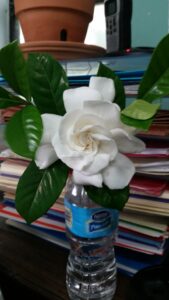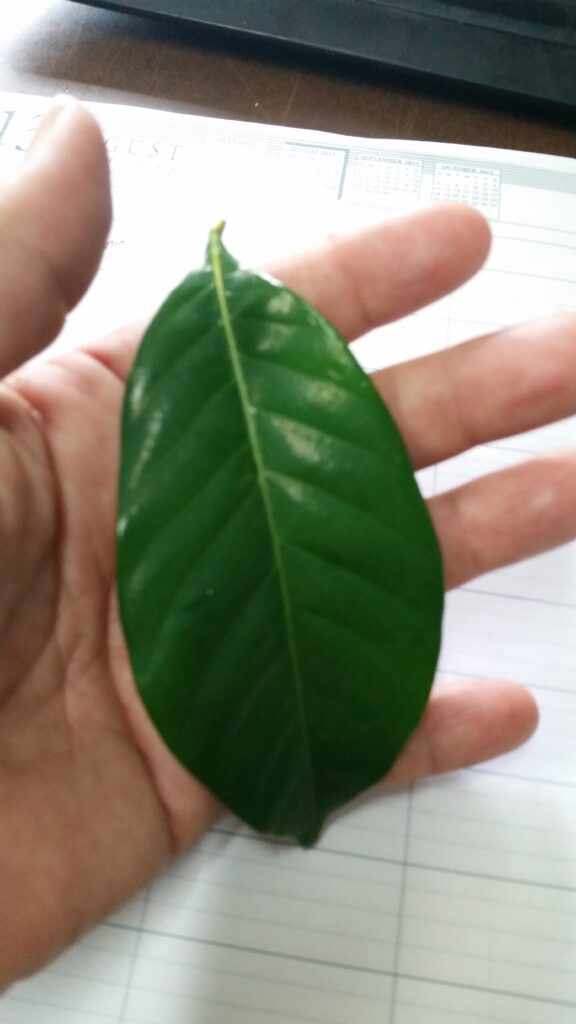S & J Nursery’s Guide to Growing
Mystery Gardenia Plants
in the Northeast Florida St. Augustine | Jacksonville area Landscape
Origins and Best Use of Gardenia jasminoides /grandiflora ‘Mystery’ for the Northeast Florida Jacksonville | St. Augustine area home Landscape:

– Gardenias are not for every garden setting, their beauty and fragrance are beyond comparison and are a well sought after ornamental, but they have a tendency towards fickleness that can make them a challenge for many garden locations. I once heard it said that gardenias are temperamental for a multitude of reasons, they get too little sun, too much sun, they get too wet, they are too dry, the soil they have been growing in quickly changes from wet to dry or vise versa, the PH is not right, the weather got too hot, the weather was too cold…and last but not least you looked at them funny! Of coarse that is not ALL true, I’m fairly positive gardenias don’t drop leaves and buds when you look at them sideways, but growing them can certainly make you feel that way at times! For all the fuss that gardenia plants put us through, we sure do love them anyway! Its kind of like when your beautiful child you fell in love with at the first mention of their existence, brought home perfect from the hospital and has brought you so much joy in their early years turns 13 and stops thinking your right about anything in life….that’s exactly like growing a gardenia, they start out from the garden center all beautiful and perfect everything is going wonderfully and all the sudden every leaf is yellow the buds are browning before they open and that plant is second guessing your ability to raise it properly! It can go from absolute perfection to feeling like your attempting to divert disaster pretty quickly.
So how did these particular little wonders of the plant world grow on their own before we started hybridizing them and planting them in our gardens? Who fussed with them in the wild, if they are so temperamental how did they exist in the wild at all? Well, the answer is as simple and as complicated as it can get all in the same sentence. Are you ready for it? Here goes… They are just site specific. Yep, that’s both all there is to it and the tip of the ice burg all wound up into one short little answer. Don’t worry there’s more help to come!
Gardenias are native to subtopical and tropical portions of Africa, Asia, Madagascar and Australia. They like humid hot environments that have a slightly acidic PH, consistent moisture in the soil and a good balance of sun exposure. Hopefully with a little bit of an understanding of the gardenia plants basic needs we will be able to get you growing in the right direction and feeling proud of mastering the art of growing the coveted beauty of the tropics, the wonderfully fragrant, stunningly beautiful Gardenia!
Mystery Gardenia is one of the largest growing cultivars available selected for its huge 4-5 inch fully double rose form wonderfully fragrant flowers that are set against a backdrop of large deep green glossy foliage. Really a very showy cultivar that has long been my favorite selection. Its faster growth rate and large mature size make it well suited as a larger back of the border planting or pruned up as a small ornamental tree. When a Mystery Gardenia is happy in its home, it is truly a sight to behold.
Blooms of the Mystery Gardenia:
– Gardenia blooms just may be perfection itself, they are just almost too good to be true. Mystery has large 4-5 inch wide fully double rose form blooms that are relatively thick and almost rubbery to the touch yet velvety soft with the slightest of a sheen to the bright white that makes you want to reach out and touch them. If the Blooms weren’t enough just by themselves in all of their stunning glory, there’s icing on that cake for you as well, the fragrance of a gardenia bush in bloom is like absolutely nothing else. They are sweet and musky and floral and you can smell them across the street!
Mystery gardenia is a late spring early summer bloomer.
Preferred Exposure for Gardenia mystery :

– Gardenias will grow in full sun to part sun situations or light dappled shade underneath taller canopy trees but flower the best when receiving adequate light. A good rule of thumb for your dapple d shade areas is Does Grass grow there or is it choking out grass? If the grass is growing you have light enough for flowering if grass is dead or thin in that area you have heavy shade and may not get enough light for good flower production.
Things to keep in mind when selecting a place for your gardenia is that ALL OTHER REQUIREMENTS of the plant would need to be perfect for it to tolerate that full sun location. Consistent watering, moist rich well draining soils and a PH between 5-5.5. All play a part in your tolerated sun exposure. I find planting them in morning sun and afternoon shade the Ideal placement here in Northeast Florida. Experiment with the sun shade tolerance as you wish. There’s an old garden saying that I have always found funny… “Plant one where the book tells you, plant one where you think it wont live, and plant one where you think it will be the perfect spot. One of those will live!” I find with gardenias, they just might surprise you.
Quick Note: In Northeast Florida, a plant receiving 6 hours or more of sun exposure is considered to be planted in a full sun location. Afternoon sun with morning shade during the summer where it remains above 80 degrees till 7 and 8 PM is the same as an all day sun exposure and at the hottest time of the year. Also a quick note to remember be mindful of where the sun will be during the summer months, what is sun/ shade in winter and summer can differ.
– Fairly cold tolerant in our climate zone here in Northeast Florida, Gardenias may sometimes still suffer winter damage on new growth that has not had enough time to harden off before a freeze. Make sure your last pruning is before October.
Soil Preference / Salt tolerance of the Mystery Gardenia:
– The plant prefers consistantly moist, well-drained, fertile, soil that has high organic matter content. ( compost acts as a sponge soaking up water and releasing it slowly as needed for the plant solving both dry sandy soil and heavy clay soil issues at the same time) Amend with compost generously when planting into dry sandy soils. And keep the plants away from high alkaline areas like new home foundations, new driveways and concrete walkways, areas with heavy shell in the soils that all can raise the PH of the soil out of its ideal range for gardenias. Gardenias tend to be happiest in in slightly acid ( PH5-5.5 ) soils and will suffer from chlorosis in high alkalinity ( anything over PH7).
– Gardenias have poor salt tolerance.
Size and Growth of the Mystery Gardenia:
Size: can reach heights of 6-8 ft ft in height and 8 ft in width if left unpruned to grow up as a small scale ornamental tree. Gardenias respond well to light pruning and can be maintained at the desired height and fullness with semi-annual trimming.
Growth Habit: Rather upright when young developing a naturally rounded shaped or rounded canopy with some pruning for fullness with age.
Growth Rate: moderately fast growing plant, expect approximately 6-12 inches ft of growth annually in the first few seasons.
Water Requirements of the Mystery Gardenia :
– One of the struggles with gardenia plants lies in the fact that they need consistent moisture. That can often be a challenge in Florida’s sandy soil areas. Established into the landscape with a fully developed root system these plants require less frequent watering but are not highly drought resistant and should be given supplemental irrigations twice a week in most soils. Daily hand watering is necessary to get the plant rooted and growing on its own after being planted in the ground from an S & J Nursery container. A 3-6 inch layer of arborist wood chips or pine bark/ pine straw applied to the area on top of the soil once to twice a year in combination with compost amendment at planting time helps the soil retain the moisture it gets from rain and supplemental irrigation allowing the soil moisture level to remain more consistent. Both of those mulches also break down into rich compost to feed the plant and improve the soil structure over the years and help keep your plant happy. Just remember if your soil is less than perfect and your gardenia foliage does and all over yellow and drops leaves right when our rain season stops and starts, its reacting to that soil moisture change and it will sort itself out. Don’t panic. Remember it prefers consistency, but we all just don’t get everything we want now do we? It will adjust give it some time, it will most likely sort itself out and re bud new leaves without our intervention.
Care of the Mystery Gardenia in the Northeast Florida Landscape:
– Amend sandy soils generously with a good quality compost when planting to help your Gardenia plants get established quickly.
Here is a link to S & J Tree Farm and Nurseries Guide to Planting Your Plants into their New Home
– Water every day during the establishment period after planting in the garden from an S & J Nursery container. Be sure to continue supplemental irrigation during the hot summer months during prolonged droughts. Here is a link for S & J Tree Farm and Nurserys information on how to water your newly installed plantings in the Northeast Florida landscape
– Fertilize once each season. Gardenias are heavy feeders and it takes a lot of nutrients to make all those big beautiful flowers. Fertilize with ACID LOVING plant food in early spring, early summer and early fall. I like to use Hollytone or Osmocote for Azaleas and Camellias, (the purple label).
–Mulch thickly at least once a year with arborist wood chips Pine bark or pine straw. Pine Straw is my personal favorite but all of these break down quickly in the landscape, aid in moisture retention and improve the soil structure over time.
– Make your last summer pruning in August or September giving your Gardenia plant ample time to recover growing new foliage that will harden off before winter arrives for us here in late December. Pruning too late into the fall will cause flushes of cold sensitive new growth that can freeze during a heavy frost. If you get tip burn, wait until all danger of frost has past for your area and trim below the damaged tips.

